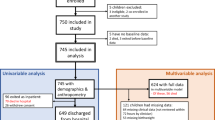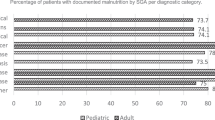Abstract
Approximately 11% of children worldwide suffer from moderate or severe acute malnutrition, which is defined as low weight for height or mid-upper arm circumference with respect to international standards, or the presence of bipedal edema. These children have a considerably increased risk of dying. Experience from the past two decades indicates that children with uncomplicated moderate or severe acute malnutrition can be managed successfully as outpatients, by use of appropriate treatment of infections and either lipid-based, ready-to-use therapeutic foods or appropriately formulated home diets, along with psychosocial care. Children's caregivers prefer community-based treatment, which is also less costly than inpatient care. Children with severe acute malnutrition and life-threatening complications require short-term inpatient care for treatment of infections, fluid and electrolyte imbalances, and metabolic abnormalities. Initial dietary management relies on low-lactose, milk-based, liquid formulas but semi-solid or solid foods can be started as soon as appetite permits, after which children can be referred for ambulatory treatment. National programs for the community-based management of acute malnutrition (CMAM) provide periodic anthropometric and clinical screening of young children, and referral of those who meet established criteria. This Review describes the main components of the treatment of young children with acute malnutrition in resource poor settings and some recent advances in CMAM programs.
Key Points
-
Moderate and severe acute malnutrition are relatively common in resource-poor settings, which leads to high rates of infant and child mortality
-
Children can be screened for acute malnutrition by measurement of either weight for height or mid-upper arm circumference and inspection for the presence of bipedal edema
-
Treatment algorithms have been developed that are based on the severity of malnutrition and the presence of clinical complications or reduced appetite
-
Children with severe acute malnutrition and good appetite can be managed as ambulatory patients by infection treatment and the use of ready-to-use therapeutic foods (RUTF) or appropriately formulated home diets
-
The optimal management of children with moderate acute malnutrition (namely use of RUTF versus specialized home-prepared diets) is being investigated to develop simple, effective and affordable dietary regimens
This is a preview of subscription content, access via your institution
Access options
Subscribe to this journal
Receive 12 print issues and online access
$209.00 per year
only $17.42 per issue
Buy this article
- Purchase on Springer Link
- Instant access to full article PDF
Prices may be subject to local taxes which are calculated during checkout
Similar content being viewed by others
References
Briend, A., Prudhon, C., Prinzo, Z. W., Daelmans, B. M. & Mason, J. B. Putting the management of severe malnutrition back on the international agenda. Food Nutr. Bull. 27 (Suppl. 3), S3–S6 (2006).
Amadi, B. et al. Reduced production of sulfated glycosaminoglycans occurs in Zambian children with kwashiorkor but not marasmus. Am. J. Clin. Nutr. 89, 592–600 (2009).
UNICEF. State of the World's Children 2009: Maternal and Newborn Health (UNICEF, New York, 2009).
Myatt, M. & Duffield, A. Weight-for-height and MUAC for estimating the prevalence of acute undernutrition? [online] (2007).
Prudhon, C., Prinzo, Z. W., Briend, A., Daelmans, B. M. & Mason, J. B. Proceedings of the WHO, UNICEF, and SCN informal consultation on community-based management of severe malnutrition in children. Food Nutr. Bull. 27 (Suppl. 3), S99–S104 (2006).
WHO, World Food Programme, United Nations System Standing Committee on Nutrition & UNICEF. Community-based management of severe acute malnutrition [online] (2007).
Black, R. E. et al. Maternal and child undernutrition: global and regional exposures and health consequences. Lancet 371, 243–246 (2008).
Schroeder, D. G. & Brown, K. H. Nutritional status as a predictor of child survival: summarizing the association and quantifying its global impact. Bull. World Health Organ. 72, 569–579 (1994).
Pelletier, D. L., Frongillo, E. A. Jr, Schroeder, D. G. & Habicht, J. P. The effects of malnutrition on child mortality in developing countries. Bull. World Health Organ. 73, 443–448 (1995).
World Health Organization. Management of severe malnutrition: a manual for physicians and other senior health workers [online] (1999).
Briend, A. et al. Ready-to-use therapeutic food for treatment of marasmus. Lancet 353, 1767–1768 (1999).
Collins, S. et al. Key issues in the success of community-based management of severe malnutrition. Food Nutr. Bull. 27 (Suppl. 3), S49–S82 (2006).
Kauffman, C. A., Jones, P. G. & Kluger, M. J. Fever and malnutrition: endogenous pyrogen/interleukin-1 in malnourished patients. Am. J. Clin. Nutr. 44, 449–452 (1986).
Manary, M. J. & Brewster, D. R. Potassium supplementation in kwashiorkor. J. Pediatr. Gastroenterol. Nutr. 24, 194–201 (1997).
Dutta, P. et al. Double blind, randomised controlled clinical trial of hypo-osmolar oral rehydration salt solution in dehydrating acute diarrhoea in severely malnourished (marasmic) children. Arch. Dis. Child. 84, 237–240 (2001).
Alam, N. H., Hamadani, J. D., Dewan, N. & Fuchs, G. J. Efficacy and safety of a modified oral rehydration solution (ReSoMaL) in the treatment of severely malnourished children with watery diarrhea. J. Pediatr. 143, 614–619 (2003).
Fergusson, P. & Tomkins, A. HIV prevalence and mortality among children undergoing treatment for severe acute malnutrition in sub-Saharan Africa: a systematic review and meta-analysis. Trans. R. Soc. Trop. Med. Hyg. 103, 541–548 (2009).
Ashworth, A., Bell, R., James, W. P. & Waterlow, J. C. Calorie requirements of children recovering from protein-calorie malnutrition. Lancet 2, 600–603 (1968).
Brown, K. H. et al. Effects of dietary energy density and feeding frequency on total daily energy intakes by recovering malnourished children. Am. J. Clin. Nutr. 62, 13–18 (1995).
Fjeld, C. R., Schoeller, D. A. & Brown, K. H. Body composition of children recovering from severe protein-energy malnutrition at two rates of catch-up growth. Am. J. Clin. Nutr. 50, 1266–1275 (1989).
Diop, E. I., Dossou, N. I., Ndour, M. M., Briend, A. & Wade, S. Comparison of the efficacy of a solid ready-to-use food and a liquid, milk-based diet for the rehabilitation of severely malnourished children: a randomized trial. Am. J. Clin. Nutr. 78, 302–307 (2003).
Manary, M. J., Ndkeha, M. J., Ashorn, P., Maleta, K. & Briend, A. Home based therapy for severe malnutrition with ready-to-use food. Arch. Dis. Child. 89, 557–561 (2004).
Ciliberto, M. A. et al. Comparison of home-based therapy with ready-to-use therapeutic food with standard therapy in the treatment of malnourished Malawian children: a controlled, clinical effectiveness trial. Am. J. Clin. Nutr. 81, 864–870 (2005).
Ndekha, M. J., Manary, M. J., Ashorn, P. & Briend, A. Home-based therapy with ready-to-use therapeutic food is of benefit to malnourished, HIV-infected Malawian children. Acta Paediatr. 94, 222–225 (2005).
Sandige, H., Ndekha, M. J., Briend, A., Ashorn, P. & Manary, M. J. Home-based treatment of malnourished Malawian children with locally produced or imported ready-to-use food. J. Pediatr. Gastroenterol. Nutr. 39, 141–146 (2004).
Collins, S. & Sadler, K. Outpatient care for severely malnourished children in emergency relief programmes: a retrospective cohort study. Lancet 360, 1824–1830 (2002).
Ciliberto, M. A., Manary, M. J., Ndekha, M. J., Briend, A. & Ashorn, P. Home-based therapy for edematous malnutrition with ready-to-use therapeutic food. Acta Paediatr. 95, 1012–1015 (2006).
Linneman, Z. et al. A large-scale operational study of home-based therapy with ready-to-use therapeutic food in childhood malnutrition in Malawi. Matern. Child. Nutr. 3, 206–215 (2007).
Lopriore, C., Guidoum, Y., Briend, A. & Branca, F. Spread fortified with vitamins and minerals induces catch-up growth and eradicates severe anemia in stunted refugee children aged 3–6 y. Am. J. Clin. Nutr. 80, 973–981 (2004).
Heikens, G. T., Schofield, W. N., Dawson, S. M. & Waterlow, J. C. Long-stay versus short-stay hospital treatment of children suffering from severe protein-energy malnutrition. Eur. J. Clin. Nutr. 48, 873–882 (1994).
Khanum, S., Ashworth, A. & Huttly, S. R. Controlled trial of three approaches to the treatment of severe malnutrition. Lancet 344, 1728–1732 (1994).
Hossain, M. I. et al. Impact of community-based follow-up care, with or without food supplementation and/or psychosocial stimulation, on the recovery of severely underweight Bangladeshi children: a randomized intervention trial. Proceedings of the XII Asian Conference on Diarrheal Disease, Yogyakarta (in press).
Ashworth, A. Efficacy and effectiveness of community-based treatment of severe malnutrition. Food Nutr. Bull. 27 (Suppl. 3), S24–S48 (2006).
WHO & UNICEF. WHO child growth standards and the identification of severe acute malnutrition in infants and children [online] (2009).
Golden, M. H. Proposed Recommended Nutrient Densities for Moderately Malnourished Children [online] (2008).
World Food Program. Improving corn-soy blend and other fortified blended foods, why and how (World Food Program, Rome, 2008).
Maleta, K. et al. Supplementary feeding of underweight, stunted Malawian children with a ready-to-use food. J. Pediatr. Gastroenterol. Nutr. 38, 152–158 (2004).
Matilsky, D. K., Maleta, K., Castleman, T. & Manary, M. J. Supplementary feeding with fortified spreads results in higher recovery rates than with corn/soy blend in moderately wasted children. J. Nutr. 139, 773–778 (2009).
Karaolis, N. et al. WHO guidelines for severe malnutrition: are they feasible in rural African hospitals? Arch. Dis. Child. 92, 198–204 (2007).
World Health Organization. WHO growth standards: length/height-for-age, weight-for-age, weight-for-length, weight-for-height and body mass index-for-age: methods and development (WHO, Geneva, 2006).
Acknowledgements
Helen Keller International's programs to institutionalize the community-based management of acute malnutrition in Burkina Faso, Mali and Niger are funded by the United states Agency for International Development Office of Foreign Disaster Assistance, the Richard and Rhoda Goldman Fund and the Monsanto Fund, with in-kind support from UNICEF and the World Food Program.
Author information
Authors and Affiliations
Corresponding author
Ethics declarations
Competing interests
The authors declare no competing financial interests.
Rights and permissions
About this article
Cite this article
Brown, K., Nyirandutiye, D. & Jungjohann, S. Management of children with acute malnutrition in resource-poor settings. Nat Rev Endocrinol 5, 597–603 (2009). https://doi.org/10.1038/nrendo.2009.194
Published:
Issue Date:
DOI: https://doi.org/10.1038/nrendo.2009.194
This article is cited by
-
Small-quantity lipid-based nutrient supplements, with or without added zinc, do not cause excessive fat deposition in Burkinabe children: results from a cluster-randomized community trial
European Journal of Nutrition (2022)
-
Impact of stakeholder perspectives on cost-effectiveness estimates of four specialized nutritious foods for preventing stunting and wasting in children 6–23 months in Burkina Faso
Nutrition Journal (2020)
-
Transition from F-75 to ready-to-use therapeutic food in children with severe acute malnutrition, an observational study in Uganda
Nutrition Journal (2017)
-
Prevalence and assessment of malnutrition among children attending the Reproductive and Child Health clinic at Bagamoyo District Hospital, Tanzania
BMC Public Health (2016)
-
Programmatic response to malnutrition in India: Room for more than one elephant?
Indian Pediatrics (2014)




